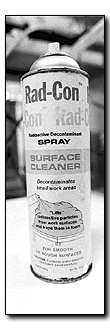![]()
![[ NEWS ]](/images/fall97/newsf97.gif)
![]()
By Greg Clark
Arizona Daily Wildcat
October 13, 1997
Radiation Control monitors the hot stuff
![[Picture]](01_4_i.gif)
Chris Richards Laboratory Manager Peg Kattnig opens the freezer where radioactive isotopes are stored in a toxicology lab at the UA College of Pharmacology and Toxicology. By attaching a radioactive marker to a given chemical compound that is fed to rats, researchers can follow the chemical to see what organs or tissues it concentrates in. |
First in three part series.
From tritium tracers to a licensed nuclear reactor, radioactive materials and radiation-producing machinery are an integral part of UA research.
About 200 University of Arizona doctors and researchers are approved to use radioactive materials in their laboratories.
Together, those researchers operate about 400 labs on campus and at the Arizona Health Sciences Center where radioactive materials are generated or used, said Pat Veccia, a radiation control specialist at the UA's Radiation Control Office.
That material and equipment is controlled by the UA's Radiation Control Office.
With a staff of 18 and an annual budget of about $1 million, the office monitors the purchasing, use, storage and disposal of all radioactive materials at the UA, said Charles Sondhaus, director of the UA's Radiation Control Office.
Biological researchers use radioactive isotopes of carbon, phosphorus, hydrogen and other elements to isolate genetic material, mark DNA and follow chemical reactions. These isotopes, known as tracers, are crucial to biological research.
"Most of what we know about the way cells behave, divide and function is because of tracer methods, which we have had for about 50 years," Sondhaus said, "And all of what we know about genetics is due to tracer methods."
At the UA, a wide range of material is used, of varying energy levels and abilities of penetrating the human body, Sondhaus said.
Most of the radioactive materials used are extremely low level tracer isotopes that do not have enough energy to penetrate the skin, but can be dangerous if ingested, Veccia said.
Working with these materials, such as carbon-14 and hydrogen-3, or tritium, researchers need only wear eye protection, lab coats and rubber gloves. Materials must be specially marked and used only in designated areas inside the lab, Veccia said.
The radiation from tritium is so weak it cannot escape the cells it is in, so there is no danger of it penetrating the skin, Sondhaus said.
Tracers are also used in the UA's Department of Nuclear Medicine to diagnose ailments from stress fractures to stroke.
More highly radioactive material is used at University Medical Center in cancer treatment and to irradiate animals for research in the UA Department of Radiation Oncology, Sondhaus said.
He said rats and mice with tumors are given high doses of radiation to study the effects of the radiation on tumors.

Chris Richards Rad-Con foam spray decontaminates work areas where
radioactive materials are used. |
Safety measures range from lead-lined reinforced concrete walls around areas where radiation producing equipment is used to lead safes for storing radioactive cesium and iridium, Sondhaus said.
The university also operates a nuclear reactor in the basement of the Engineering building for teaching and research in nuclear engineering.
The reactor is also used to test the effect of radiation on optical and electrical materials and to determine the elemental composition of rock and soil samples, said John G. Williams, professor of nuclear engineering and director of the UA's Nuclear Reactor Laboratory.
Radiation Control is responsible for assuring the safe operation of all these experiments.
A researcher who wants to use radioactive material is required to get permission from the office's "committee for approval," a body that meets every two months.
"The committee makes sure people have adequate training and experience," Veccia said. "Researchers must be approved for every different isotope they want to use."
Once approved, all radioactive material is purchased through the control office.
"We monitor everything as it comes in, while it is here and when and how it goes out. We track everything from cradle to grave," Veccia said.
Any person working with radioactive materials is required to take a four-hour training class from Radiation Control.
Annually, the office audits every approval holder and physically inspects every lab where radioactive materials are used, Veccia said.
The office is monitored by the Arizona Radiation Regulatory Agency, which itself is controlled by the Nuclear Regulatory Commission.



